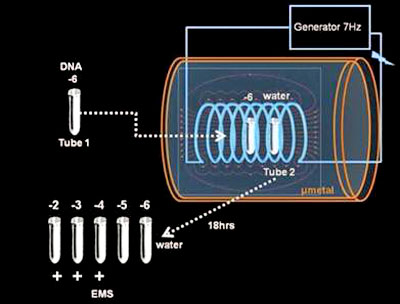|
by Andy Coghlan 12 January 2011 from SetYouFreeNews Website
A Nobel prizewinner is reporting that
DNA can be generated from its teleported "quantum imprint"
Luc Montagnier, who shared the Nobel prize for medicine in 2008 for his part in establishing that HIV causes AIDS, says he has evidence that DNA can send spooky electromagnetic imprints of itself into distant cells and fluids.
If that wasn't heretical enough, he also
suggests that enzymes can mistake the ghostly imprints for real DNA,
and faithfully copy them to produce the real thing. In effect this
would amount to a kind of quantum teleportation ("Teleportation,
But not as We Know it") of the DNA.
Jacqueline Barton, who does similar work at the California Institute of Technology in Pasadena, was equally skeptical.
One blogger has suggested Montagnier
should be awarded an
IgNobel prize.
So what have Montagnier and his team
actually found?
One tube contained a fragment of DNA
around 100 bases long; the second tube contained pure water.
The gene fragment was apparently recovered from both tubes, even though one should have contained just water (see below diagram).
In each cycle it was diluted 10-fold,
and "ghost" DNA was only recovered after between seven and 12
dilutions of the original. It was not found at the ultra-high
dilutions used in homeopathy.
This structure, they claim, is preserved and amplified through quantum coherence effects, and because it mimics the shape of the original DNA, the enzymes in the PCR process mistake it for DNA itself, and somehow use it as a template to make DNA matching that which "sent" the signal (DNA Waves and Water).
Yet according to Klaus Gerwert, who studies interactions between water and biomolecules at the Ruhr University in Bochum, Germany,
Franks was involved as a peer reviewer in the debunking of a controversial study in 1988 which claimed that water had a memory (see far below "How 'ghost molecules' were exorcised").
Despite the skepticism over Montagnier's explanation, the consensus was that the results deserve to be investigated further.
Montagnier's colleague, theoretical physicist Giuseppe Vitiello of the University of Salerno in Italy, is confident that the result is reliable.
In a paper last year (Interdisciplinary Sciences: Computational Life Sciences, DOI: 10.1007/s12539-009-0036-7), Montagnier described how he discovered the apparent ability of DNA fragments and entire bacteria both to produce weak electromagnetic fields and to "regenerate" themselves in previously uninfected cells.
Montagnier strained a solution of the bacterium Mycoplasma pirum through a filter with pores small enough to prevent the bacteria penetrating. The filtered water emitted the same frequency of electromagnetic signal as the bacteria themselves.
He says he has evidence that many
species of bacteria and many viruses give out the electromagnetic
signals, as do some diseased human cells.
In a paper in Nature (vol
333, p 816) in 1988 he claimed to show that
water had a "memory",
and that the activity of human antibodies was retained in solutions
so dilute that they couldn't possibly contain any antibody molecules
(New Scientist, 14 July 1988, p 39).
They found his result to be "a delusion", based on a flawed design.
In 1991, Benveniste repeated his experiment under double-blind conditions, but not to the satisfaction of referees at Nature and Science. Two years later came the final indignity when he was suspended for damaging the image of his institute. He died in October 2004.
Montagnier and his colleagues are hoping
that their paper won't suffer the same fate as Benveniste's.
|

